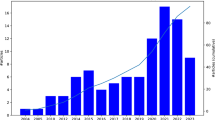Abstract
We study a novel version of the capacitated facility location problem, which includes incompatibilities among customers. For this problem, we propose and compare on a fair common ground a portfolio of metaheuristic techniques developed independently from each other. We tested our techniques on a new dataset composed of instances of increasing size, varying from medium to very large ones. The outcome is that the technique based on data mining has been able to outperform the others in most instances, except for a few large cases, for which it is overcome by the simpler greedy one. In order to encourage future comparisons on this problem, we make the instances, solution validator and implementations of the metaheuristic techniques available to the community.


Similar content being viewed by others
Data availability
The datasets generated during the current study are available at the MESS 2020+1 website, https://www.ants-lab.it/mess2020/#competition, and at https://github.com/MESS-2020-1.
References
Avella P, Boccia M (2009) A cutting plane algorithm for the capacitated facility location problem. Comput Optim Appl 43(1):39–65
Avella P, Boccia M, Sforza A et al (2009) An effective heuristic for large-scale capacitated facility location problems. J Heuristics 15(6):597
Avella P, Boccia M, Mattia S et al (2021) Weak flow cover inequalities for the capacitated facility location problem. Eur J Oper Res 289(2):485–494
Barahona F, Chudak FA (2005) Near-optimal solutions to large-scale facility location problems. Discrete Optim 2(1):35–50
Birattari M, Yuan Z, Balaprakash P et al (2010) F-race and iterated F-race: an overview. In: Experimental methods for the analysis of optimization algorithms. Springer, Berlin, pp 311–336
Caserta M, Voß S (2020) A general corridor method-based approach for capacitated facility location. Int J Prod Res 58(13):3855–3880
Cornuéjols G, Nemhauser G, Wolsey L (1983) The uncapacitated facility location problem. Technical report, Cornell University Operations Research and Industrial Engineering
Davis LD (1991) Handbook of genetic algorithms. Van Nostrand Reinhold, New York
Fernández E, Landete M (2015) Fixed-charge facility location problems. In: Location science. Springer, pp 47–77
Festa P, Resende MG (2018) GRASP. In: Marti R, Pardalos P, Resende M (eds) Handbook of heuristics. Springer, pp 465–488
Fischetti M, Ljubić I, Sinnl M (2016) Benders decomposition without separability: a computational study for capacitated facility location problems. Eur J Oper Res 253(3):557–569
Görtz S, Klose A (2012) A simple but usually fast branch-and-bound algorithm for the capacitated facility location problem. INFORMS J Comput 24(4):597–610
Guastaroba G, Speranza MG (2012) Kernel search for the capacitated facility location problem. J Heuristics 18(6):877–917
Ho SC (2015) An iterated tabu search heuristic for the single source capacitated facility location problem. Appl Soft Comput 27:169–178
Klose A, Drexl A (2005) Facility location models for distribution system design. Eur J Oper Res 162(1):4–29
Larrañaga P, Kuilpers C, Poza M et al (1997) Decomposing Bayesian networks: triangulation of the moral graph with genetic algorithms. Stat Comput 7:19–34
López-Ibáñez M, Dubois-Lacoste J, Pérez Cáceres L et al (2016) The irace package: iterated racing for automatic algorithm configuration. Oper Res Perspect 3:43–58
Lourenço HR, Martin OC, Stützle T (2003) Iterated local search. Springer, Boston, pp 320–353
Maia MRH, Plastino A, Penna PHV (2020) MineReduce: an approach based on data mining for problem size reduction. Comput Oper Res 122(104):995
Marín A, Pelegrín M (2019) Adding incompatibilities to the simple plant location problem: formulation, facets and computational experience. Comput Oper Res 104:174–190
Melo MT, Nickel S, Saldanha-Da-Gama F (2009) Facility location and supply chain management—a review. Eur J Oper Res 196(2):401–412
Nethercote N, Stuckey PJ, Becket R et al (2007) MiniZinc: towards a standard CP modelling language. In: Bessière C (ed) CP 2007, LNCS, vol 4741. Springer, pp 529-543
Rabbani M, Heidari R, Farrokhi-Asl H et al (2018) Using metaheuristic algorithms to solve a multi-objective industrial hazardous waste location-routing problem considering incompatible waste types. J Clean Prod 170:227–241
Rios E, Coelho IM, Ochi LS et al (2016) A benchmark on multi improvement neighborhood search strategies in CPU/GPU systems. In: 2016 international symposium on computer architecture and high performance computing workshops (SBAC-PADW), pp 49–54
Silva JCN, Coelho IM, Souza US et al (2022) Finding the maximum multi improvement on neighborhood exploration. Optim Lett 16:97–115
Urli T (2013) json2run: a tool for experiment design & analysis. CoRR arXiv:1305.1112
Funding
Marcelo R. H. Maia has received research support from the Brazilian Institute of Geography and Statistics (IBGE, Brazil). Alexandre Plastino and Uéverton S. Souza have received research support from Conselho Nacional de Desenvolvimento Científico e Tecnológico (CNPq, Brazil) (Grant Numbers 310444/2018-7 and 309832/2020-9). Uéverton S. Souza has received research support from Fundação Carlos Chagas Filho de Amparo à Pesquisa do Estado do Rio de Janeiro (FAPERJ, Brazil) (Grant Number E-26/201.344/2021).
Author information
Authors and Affiliations
Contributions
MRHM designed the MR-MS-ILS algorithm under the supervision of AP and USS. MR and CP-T designed the GRASP algorithm. PPV designed the PcEA algorithm. SC, MP and AS formulated the problem definition, generated the benchmark datasets, designed the MG algorithm and conducted the experiments. The manuscript was jointly written by all authors, who read and approved its final version.
Corresponding author
Ethics declarations
Conflict of interest
The authors have no relevant financial or non-financial interests to disclose.
Additional information
Publisher's Note
Springer Nature remains neutral with regard to jurisdictional claims in published maps and institutional affiliations.
Rights and permissions
Springer Nature or its licensor (e.g. a society or other partner) holds exclusive rights to this article under a publishing agreement with the author(s) or other rightsholder(s); author self-archiving of the accepted manuscript version of this article is solely governed by the terms of such publishing agreement and applicable law.
About this article
Cite this article
Maia, M.R.H., Reula, M., Parreño-Torres, C. et al. Metaheuristic techniques for the capacitated facility location problem with customer incompatibilities. Soft Comput 27, 4685–4698 (2023). https://doi.org/10.1007/s00500-022-07600-z
Accepted:
Published:
Issue Date:
DOI: https://doi.org/10.1007/s00500-022-07600-z




